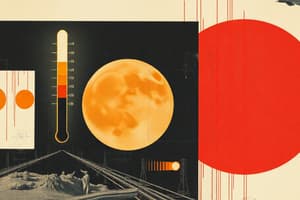Podcast
Questions and Answers
What defines matter?
What defines matter?
- Anything that has weight and can change phase.
- A combination of solids and liquids only.
- Any substance that has mass and occupies space. (correct)
- Only gases that can fill a container.
Which of these states of matter has a fixed volume but takes the shape of its container?
Which of these states of matter has a fixed volume but takes the shape of its container?
- Solid
- Gas
- Liquid (correct)
- Plasma
What process describes the change from liquid to gas?
What process describes the change from liquid to gas?
- Condensation
- Freezing
- Deposition
- Evaporation (correct)
Which measurement is commonly used to quantify mass?
Which measurement is commonly used to quantify mass?
What is the state of matter characterized by particles that are widely spaced and move freely?
What is the state of matter characterized by particles that are widely spaced and move freely?
What unit is commonly used to measure smaller quantities of mass in chemistry?
What unit is commonly used to measure smaller quantities of mass in chemistry?
Which measurement method is suitable for determining the volume of an irregularly shaped solid?
Which measurement method is suitable for determining the volume of an irregularly shaped solid?
How is weight calculated based on mass?
How is weight calculated based on mass?
Which term best describes the amount of space occupied by a substance?
Which term best describes the amount of space occupied by a substance?
What relationship exists between mass and volume in determining density?
What relationship exists between mass and volume in determining density?
What characteristic defines crystalline solids?
What characteristic defines crystalline solids?
Which property is a measure of a liquid's resistance to flow?
Which property is a measure of a liquid's resistance to flow?
In which state of matter do particles move freely at high speeds?
In which state of matter do particles move freely at high speeds?
What is the primary process occurring when ice melts into water?
What is the primary process occurring when ice melts into water?
Which statement best describes plasma?
Which statement best describes plasma?
According to the Kinetic Molecular Theory, what happens during elastic collisions of gas particles?
According to the Kinetic Molecular Theory, what happens during elastic collisions of gas particles?
What happens at the triple point in a phase diagram?
What happens at the triple point in a phase diagram?
What do physical changes involve?
What do physical changes involve?
Which of the following is an indicator of a chemical change?
Which of the following is an indicator of a chemical change?
How can salt be separated from water after dissolving?
How can salt be separated from water after dissolving?
Which of the following is a practical example of a physical change?
Which of the following is a practical example of a physical change?
What principle asserts that mass is conserved in a closed system during a chemical reaction?
What principle asserts that mass is conserved in a closed system during a chemical reaction?
What do critical points indicate in terms of phases of matter?
What do critical points indicate in terms of phases of matter?
Which of the following is an example of a physical property?
Which of the following is an example of a physical property?
What does the term 'cryogenics' refer to?
What does the term 'cryogenics' refer to?
What happens during the process of melting?
What happens during the process of melting?
Which property describes how well a substance allows the flow of heat or electricity?
Which property describes how well a substance allows the flow of heat or electricity?
What is the boiling point of water at standard atmospheric pressure?
What is the boiling point of water at standard atmospheric pressure?
Which of the following describes a physical change?
Which of the following describes a physical change?
What is solubility?
What is solubility?
Which statement best describes the liquid phase of a substance?
Which statement best describes the liquid phase of a substance?
What describes the process of condensation?
What describes the process of condensation?
Flashcards are hidden until you start studying
Study Notes
Matter, Mass, and Volume
- Matter is anything that has mass and takes up space.
- Mass is the amount of matter in an object, measured in grams (g), kilograms (kg), or milligrams (mg).
- Volume is the amount of space that matter occupies, measured in cubic meters (m³), liters (L), or milliliters (mL).
States of Matter
- Solid has a fixed shape and volume, particles are tightly packed and vibrate in place.
- Liquid has a fixed volume but takes the shape of the container, particles can move past each other.
- Gas has no fixed shape or volume, particles are widely spaced and move freely.
- Plasma is ionized gas with free electrons and ions, found in stars and certain flames.
Physical Properties
- Physical properties are characteristics that can be observed or measured without changing the substance's chemical composition.
- Types of physical properties:
- State: the physical state of a substance (solid, liquid, gas).
- Color: the visible characteristic of the substance.
- Odor: the smell of the substance.
- Texture: the feel or surface quality of the substance, like smoothness or roughness.
- Density: the mass per unit volume of the substance; a measure of how tightly packed matter is.
- Melting Point: the temperature at which a solid becomes a liquid.
- Boiling Point: the temperature at which a liquid becomes a gas.
- Solubility: the ability of a substance to dissolve in a solvent.
- Conductivity: the ability of a substance to conduct heat or electricity.
Physical Changes
- Physical changes are alterations in a substance's state or appearance that do not affect its chemical composition.
- Types of Physical Changes:
- Changes in State: transitions between solid, liquid, and gaseous phases (melting, freezing, evaporation, condensation).
- Changes in Shape: altering the shape of the substance without changing its chemical identity (bending, cutting, molding).
- Changes in Size: altering the size of the substance without changing its chemical identity (breaking, crushing, grinding).
- Changes in Texture: altering the texture of the substance without changing its chemical identity (mixing, stirring, shaking).
Kinetic Molecular Theory (KMT)
- Gas particles are in constant motion, colliding with each other and the walls of their container.
- There are no intermolecular forces between gas particles, allowing them to spread out and fill the container.
- Collisions between gas particles are elastic, meaning no kinetic energy is lost.
- The temperature of a gas is a measure of the average kinetic energy of its particles.
Phase Diagrams
- Phase diagrams are graphical representations showing the relationship between temperature, pressure, and the states of matter.
- Components of phase diagrams:
- Phase Boundaries: lines on the diagram represent conditions where two phases coexist in equilibrium.
- Triple Point: the point where all three phases coexist in equilibrium.
- Critical Point: the point where the liquid and gas phases become indistinguishable, resulting in a supercritical fluid.### Physical Properties
- Physical Properties: Attributes of a substance that can be observed or measured without altering its chemical identity
- Importance:
- Identification of Substances
- Predicting Behavior
- Application in Processes
- Types:
- State of Matter: Solid, Liquid, Gas
- Color
- Odor
- Texture
- Density: The mass of a substance per unit volume (g/cm³)
- Melting and Boiling Points: Temperature at which a solid turns into a liquid, and liquid turns into gas
- Solubility: The ability of a substance to dissolve in a solvent
- Conductivity: Ability to conduct heat or electricity
Physical Changes
- Physical Changes: Transformations that affect a substance's state or appearance but do not alter its chemical composition
- Types:
- Changes in State:
- Melting: Solid → Liquid
- Freezing: Liquid → Solid
- Evaporation: Liquid → Gas
- Condensation: Gas → Liquid
- Changes in Size or Shape:
- Cutting
- Crushing
- Mixing
- Blending
- Dissolving
- Changes in State:
Distinguishing Physical and Chemical Changes
- Physical Changes: Do not alter the chemical identity of a substance
- Examples: Melting ice, dissolving sugar
- Chemical Changes: Involve a change in the substance's chemical composition, forming new substances with different properties
- Indicators: Color change, gas production, temperature change, precipitate formation
Practical Applications
- Everyday Life:
- Cooking
- Manufacturing
- Environmental Processes
- Scientific Practice:
- Material Science
- Pharmaceuticals
- Analytical Chemistry
Experimental Demonstrations
- Melting Ice:
- Observe the physical change of ice melting into water
- Measure the mass before and after melting to demonstrate the conservation of mass
- Dissolving Salt in Water:
- Observe the physical change of salt dissolving in water
- Recover the salt by evaporating the water
- Mixing Sand and Salt:
- Separate a mixture of sand and salt using physical methods (filtration and evaporation)
Studying That Suits You
Use AI to generate personalized quizzes and flashcards to suit your learning preferences.




